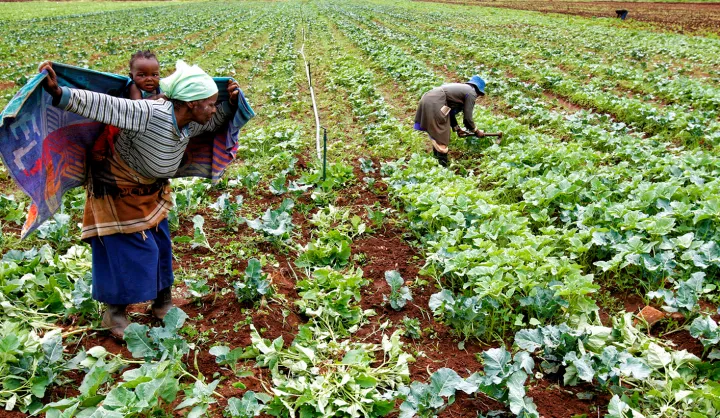South Africa
Op-Ed: Rural transformation as a solution to poverty in South Africa

Whilst rural areas are dynamic and vibrant communities, they are chronically under-invested in. Poverty rates tend to be at least double than that of urban centres. Subsistence farming and small-scale farming is key to achieving sustainable development and a key source of livelihood for most of rural communities in South Africa. By MTHANDAZO NDLOVU
Around a third of South Africa’s population lives in rural areas. Amongst these people are the country’s most vulnerable. They are excluded from the formal economy, and are denied the proceeds of profitable agriculture and mineral resources and access to land. Resistance from community activists, mine workers and farmworkers against commercial mining and agricultural entities have come into the public eye in recent years, while the “land question” has come to the fore in public discourse in South Africa.
Subsistence farming and small-scale farming is key to achieving sustainable development and a key source of livelihood for most of rural communities in South Africa. However, land reform remains a central factor in determining the success of a rural transformation and achievement of a more sustainable and inclusive development agenda.
To understand and appropriately deal with the scourge of rural poverty in South Africa, we have to take into consideration land dispossession, the structure and nature of the economy, sources of livelihoods and the role played by traditional leadership in rural areas. Consequently, any intervention aimed at development and transformation of rural areas must start with issue of land, who owns it, who uses it and for what purposes. Society at large needs to reflect and strengthen its own understanding and analysis of the impact of elite-state capture on the delivery of basic services in rural areas and how ultimately public policy choices such as land redistribution continues to favour a few.
Despite progressive legislation, women tend to have less access to economic prosperity, particularly for those living in rural areas and under the dual governance system. Women in rural areas have less access to health facilities, income security, and ways to sustain their livelihoods. In addition, high levels of gender-based violence, buoyed by deep seated patriarchy that continues to plague South Africa, compromises women’s economic and social empowerment and access to redress. Violence makes and keeps women poor.
At a continental level, 57% of Africa’s total labour force is found in agriculture, and farming is the main source of income for 90% of Africa’s rural population. Whilst rural areas are dynamic and vibrant communities, they are chronically under-invested in. Poverty rates tend to be at least double than that of urban centres.
Consequently, 1% growth in per capita agricultural GDP has been shown to reduce poverty for the ‘ultra-poor’ by five times more than a 1% increase in per capita GDP in other sectors. In addition, growth generated through small-scale farming is more likely to lead to poverty reduction due to the greater intensity of labour on small farms than larger farms.
Despite the sector’s importance, it suffers from a lack of investment over recent decades. In 2005-2006, donors were spending less than 5% of aid on agriculture and only ten out of 44 African countries had met their commitments under the 2003 Maputo Declaration to spend 10% of national budgets on agriculture.
Oxfam’s recently launched report, “Starting with People: A human economy approach to inclusive growth in Africa”, explores the potential of the people’s economy to achieve inclusive economic growth, focussing first and foremost on what works for people, not simply what raises GDP. A people’s economy approach to an industrial strategy for Africa would invest in economic activities based primarily on their ability to rapidly reduce poverty. In most countries across Africa, this would mean the prioritisation of agriculture.
Adopting a people’s economy strategy means investing in smallholder agriculture. Over half of Africa’s total labour force works in agriculture, and rural poverty rates are around double those found in urban areas. But governments should avoid a focus on large scale projects targeted at supporting the industrialisation of agriculture, and instead focus on what works for women and other marginalised groups.
A people’s economy approach to agricultural led development would ensure that the poorest people are part of this success, and don’t risk further marginalisation. Unfortunately, the favoured approach of many governments, supported by multi-lateral aid agencies, of investing in large scale projects targeted at supporting the industrialisation of agriculture and “mega” public-private-partnerships risks doing just that: bypassing the needs of the poorest and leaving the priorities of women unmet. Much of the investment incentive in these models is the availability of fertile land at a good price, and so it is land that is sold. And whilst there are local linkages, these are often with wealthier, more immediately commercially viable farmers.
Governments should instead prioritise investment in agriculture that will boost incomes and security for the poorest, and women. Public investment in extension workers to train both men and women is needed, as well as ensuring access to credit, technology, social protection to help minimise risk, and support (both financial and technical) to help farmers adapt to a changing climate. A people’s economy should also ensure that women working in agriculture or other informal sectors receive the training, investment, land rights and social protection they need to be economically successful.
Government should focus on public investment targeted at the needs of small-scale agricultural producers. This should include a target-based timeline and monitoring mechanism to meet and then exceed the Maputo Declaration for governments to spend 10% of their national budget on agriculture, prioritising investments in R&D, extension services, infrastructure and social protection.
Distribution of power is skewed in favour of urban development in South Africa and any rural transformation agenda must strategically invest in mobilising the collective power and capacity of rural communities to assert their right to equitable distribution of resources and strengthen their ability to engage both state and non-state actors for policy influence and expression of political choices.
To realise the “South Africa We Want” through rural transformation agenda, some of the strategic choices that must be pursued and supported must ensure that:
- rural communities are enabled and supported to develop sustainable institutional capacity to foster alternative thinking and practice on sustainable rural livelihood options;
- rural communities exercise power to secure their rights to essential public services and social protection, advance and enhance women and girls gain power to secure their rights; and
- rural people, grassroots movements, and civil society organisations are supported to develop their organisational and human capacity to strengthen activism and develop alternatives to citizen’s participation and support resistance and spaces for dialogue and collective action by rural people, including farm workers and dwellers is supported. DM
Mthandazo Ndlovu Heads Democracy, Governance and Strategic Alliances Programme at Oxfam South Africa.
Photo: A farm worker (L) carries her child on her back at a farm in Eikenhof outside Johannesburg February 15, 2010. REUTERS/Siphiwe Sibeko.
Oxfam South Africa advances a vision of a just society without poverty and inequality where power and resources are shared, and everyone lives in dignity.















 Become an Insider
Become an Insider